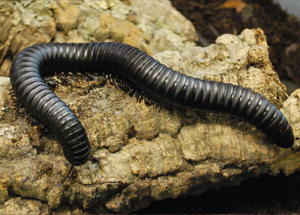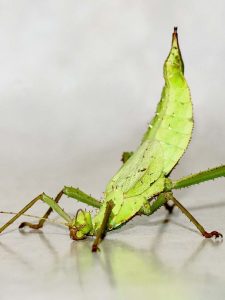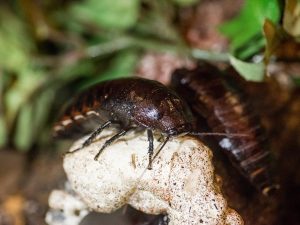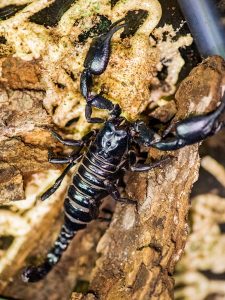Arthropod
Giant African Millipede
 COMMON NAME: Giant African Millipede
COMMON NAME: Giant African Millipede
SCIENTIFIC NAME: Archispirostreptus gigas
The Giant African Millipede is found in subtropical, Western Africa. They are detrivores, with a diet consisting of decaying organic material.
Millipedes are often confused with centipedes. Millipedes have two pairs of legs per body segment, a rounded body, and a dull coloration, whilst centipedes have a single pair of legs per body segment, a flattened body and are often brightly colored.
This species has no eyes and navigates their environment using their antennae. They also have weak mouth parts and are largely incapable of inflicting a painful bite. When threatened, they will curl up and secrete a foul substance to deter predators.
Fun fact: Millipedes breathe through tiny holes along their exoskeleton, called spiracles.
Giant Spiny Stick Insect
COMMON NAME: Giant Spiny Stick Insect
SCIENTIFIC NAME: Eurycantha calcarata
TYPE: Invertebrate
DIET: Herbivore
GROUP NAME: -
LIFESPAN: 12 - 18 yrs
SIZE: 4 - 6 in
WEIGHT: -
STATUS: Not Listed
THREATS: None
FUN FACT: Giant spiny stick males have huge spines on their back legs. Males can secrete a foul odor to ward off predators.
Jungle Nymph
 COMMON NAME: Jungle Nymph
COMMON NAME: Jungle Nymph
SCIENTIFIC NAME: Heteropteryx dilatata
The Jungle Nymph is a species of large stick insect found in the tropical rainforests of Southeast Asia, where it feeds upon leaves, such as that of the Guava Tree.
Jungle Nymphs are sexually dimorphic, meaning that males and females differ in their appearance. The female is heavy bodied, with short wings and a bright green to yellow body which resembles a leaf rather than a stick. The male is thinner, has longer wings and is stick-like with a brown, mottled coloration.
Fun facts: Jungle Nymph bodies are covered in hard spines. When threatened, the female will raise her spiny hind legs and snap them together if a potential predator gets too close.
Madagascar Hissing Cockroach
 COMMON NAME: Madagascar Hissing Cockroach
COMMON NAME: Madagascar Hissing Cockroach
SCIENTIFIC NAME: Gromphadorhina portentosa
Native to the island country of Madagascar, these large cockroaches are nocturnal and can be found beneath logs and amongst the leaf litter of the forest floor. They are detritivores, feeding on rotting organic matter. By removing decaying materials, they contribute to the health of the ecosystem.
Fun facts: This species ‘hisses’ by pushing air through respiratory orifices or ‘spiracles’ along either side of its body.
Peppered Cockroach
COMMON NAME: Peppered Cockroach
SCIENTIFIC NAME: Archimandrita tesselata
TYPE: Invertebrate
DIET: Omnivore
GROUP NAME: -
LIFESPAN: 2 yrs
SIZE: 3 - 4 in
WEIGHT: -
STATUS: Not Listed
THREATS: None
FUN FACT: These cockroaches are closely related to the first winged insects that lived in the Carboniferous coal forests about 200 million years ago.
Sabah Thorny Stick Insect
COMMON NAME: Sabah Thorny Stick Insect
SCIENTIFIC NAME: Aretaon asperrimus
TYPE: Invertebrate
DIET: Herbivore
GROUP NAME: -
LIFESPAN: 9 mths to 1 ½ yrs
SIZE: Male: 2 in, Female: 3 – 3 ½ in
WEIGHT: -
STATUS: Not Listed
THREATS: None
FUN FACT: Along with a repulsive scent, these insects will make a slight ‘croaking’ noise with their mandibles when disturbed.
Asian Forest Scorpion
 COMMON NAME: Asian Forest Scorpion
COMMON NAME: Asian Forest Scorpion
SCIENTIFIC NAME: Heterometrus spinifer
TYPE: Invertebrate
DIET: Carnivore
GROUP NAME:
LIFESPAN:
SIZE:
WEIGHT:
STATUS:
THREATS:
FUN FACT:
Red-Kneed Tarantula
COMMON NAME: Red-Kneed Tarantula
SCIENTIFIC NAME: Brachypelma smithii
Found largely along the Pacific Coast of Mexico, this Tarantula is named for the reddish hair found on the joints of their limbs.
They prefer dry forest and desert areas, where they will feed on insects and other small animals.
This species sometimes falls prey to the Tarantula Hawk. This large wasp will vibrate at the entrance of a Tarantula den to draw them out and then sting, resulting in paralysis for the Tarantula. The wasp will then lay their eggs inside the Tarantula, providing a food source for the emerging larvae.
Fun Fact: This species is able to sense vibration, smell and taste via sensory hairs located on the ends of their legs.
Vietnamese Walking Stick
COMMON NAME: Vietnamese Walking Stick
SCIENTIFIC NAME: Baculum extradentatum
The Vietnamese Walking Stick feeds solely upon foliage and has mouthparts which are specially adapted to chew leaves, opening horizontally rather than vertically.
Males are quite rare among this species. Females are capable of reproducing asexually and may produce hundreds of viable eggs without mating.
Fun Fact: Walking Sticks are often referred to as phasmids. Phasmid is derived from the Latin word ‘phasma,’ meaning ghost or apparition. Phasmids have strong camouflage or mimicking abilities, sometimes seeming to appear from nowhere.
